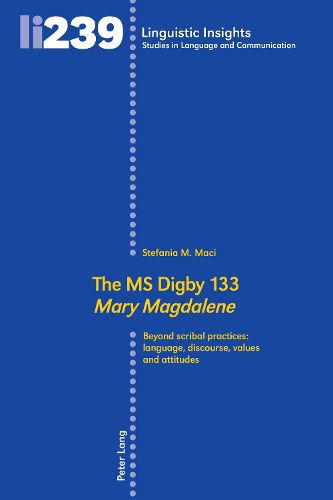Readings Newsletter
Become a Readings Member to make your shopping experience even easier.
Sign in or sign up for free!
You’re not far away from qualifying for FREE standard shipping within Australia
You’ve qualified for FREE standard shipping within Australia
The cart is loading…






This title is printed to order. This book may have been self-published. If so, we cannot guarantee the quality of the content. In the main most books will have gone through the editing process however some may not. We therefore suggest that you be aware of this before ordering this book. If in doubt check either the author or publisher’s details as we are unable to accept any returns unless they are faulty. Please contact us if you have any questions.
The MS 133 Digby Mary Magdalene has commonly been investigated by paying attention to literary features, while linguistic aspects have seldom been taken into consideration, with the result that any deviation from the norm has been classified as scribal inconsistency. However, what has been regarded as scribal carelessness actually seems to be a modern misunderstanding of scribal practices. Indeed, the significant combination of Southern, Midlands and Northern elements featuring in the language of Mary Magdalene is the result of the scribe’s desire to faithfully reproduce the author’s design, in which variants may have a marked social function. We can thus infer that the Mary Magdalene author probably created a sort of biblical koine, shared with the audience, which was realized with the linguistic varieties offered by the existing late Middle English dialects and clearly exploited not only for poetic but also, and above all, for religious purposes. At the same time, the text puts an innovative emphasis on the figure of Mary Magdalene, who simultaneously plays the role of sinner and saint, virgin and prostitute, female and male. Thanks to the methodological approach of this volume, the author shows that most unusual forms are diatopic and diastratic alternatives used in specific religious contexts to realize well-defined sociolinguistic purposes.
$9.00 standard shipping within Australia
FREE standard shipping within Australia for orders over $100.00
Express & International shipping calculated at checkout
This title is printed to order. This book may have been self-published. If so, we cannot guarantee the quality of the content. In the main most books will have gone through the editing process however some may not. We therefore suggest that you be aware of this before ordering this book. If in doubt check either the author or publisher’s details as we are unable to accept any returns unless they are faulty. Please contact us if you have any questions.
The MS 133 Digby Mary Magdalene has commonly been investigated by paying attention to literary features, while linguistic aspects have seldom been taken into consideration, with the result that any deviation from the norm has been classified as scribal inconsistency. However, what has been regarded as scribal carelessness actually seems to be a modern misunderstanding of scribal practices. Indeed, the significant combination of Southern, Midlands and Northern elements featuring in the language of Mary Magdalene is the result of the scribe’s desire to faithfully reproduce the author’s design, in which variants may have a marked social function. We can thus infer that the Mary Magdalene author probably created a sort of biblical koine, shared with the audience, which was realized with the linguistic varieties offered by the existing late Middle English dialects and clearly exploited not only for poetic but also, and above all, for religious purposes. At the same time, the text puts an innovative emphasis on the figure of Mary Magdalene, who simultaneously plays the role of sinner and saint, virgin and prostitute, female and male. Thanks to the methodological approach of this volume, the author shows that most unusual forms are diatopic and diastratic alternatives used in specific religious contexts to realize well-defined sociolinguistic purposes.